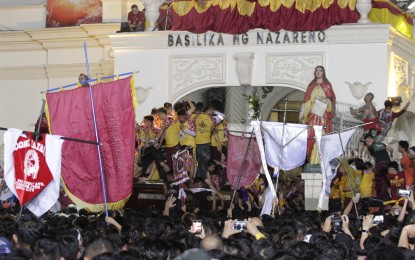
BACK TO QUIAPO CHURCH. After 16 hours since it left the Quirino Grandstand, the Black Nazarene returns to the Quiapo Church at exactly 8:50 p.m. on Thursday (Jan. 9, 2020). Compared to previous years, this year's Traslacion reached the Quiapo Church much earlier. (PNA photo by Avito C. Dalan)
MANILA -- Officials of the Minor Basilica of the Black Nazarene in Quiapo, Manila said Thursday's Traslacion or the annual procession of the Black Nazarene was one of the fastest in history.
According to Msgr. Hernando Coronel, the 16-hour procession of the image of the Black Jesus Christ from the Quirino Grandstand in Luneta to the Basilica, located along Quezon Boulevard, was faster compared to previous years.
“One of the fastest in recent memory. But I think the first one was really fast. There were no devotees climbing into the andas (carriage) -- no andas, no lubid (rope) then,” Coronel said in an interview on Friday, a day after the feast of the Black Nazarene.
On the other hand, Quiapo Church Parochial Vicar Fr. Douglas Badong said the just-concluded Church event was the most orderly procession to date.
“The fastest and most orderly procession so far,” Badong said. “We can attribute this to the cooperation between the church and the local government, to the support of the mayor (Francisco "Isko Moreno" Domagoso) and government agencies, especially the police.”
At the same time, he defended the establishment of the andas wall, which was composed of members of the Philippine National Police (PNP) who guarded both sides of the carriage during the early part of the procession.
This came amid claims that the wall prevented devotees from getting close or touching the image.
“Hindi po sila pinagbawalan makalapit sa Nazareno. Ang andas wall ay hindi inilagay para pagbawalan silang makalapit kundi para mas maging peaceful at orderly ang ruta ng prusisyon (They were not prohibited from getting near the Nazareno. The andas wall was put not to keep them away but to ensure a peaceful and orderly procession),” Badong added.
This year's Traslacion lasted 16 hours from the time it left the Quirino Grandstand stage at 4:16 a.m. up to its arrival at the Basilica before 9 p.m.
The event started an hour earlier compared to previous years.
The route of the procession was also shortened by 300 meters, passing through Ayala Bridge instead of Jones Bridge.
In 2019, the procession lasted about 21 hours. (PNA)
